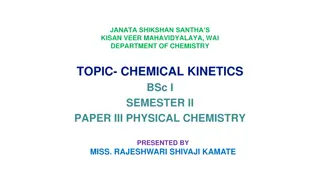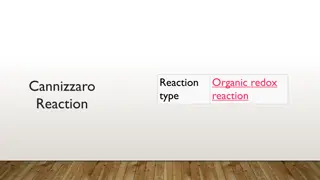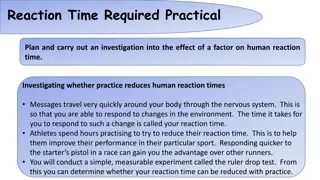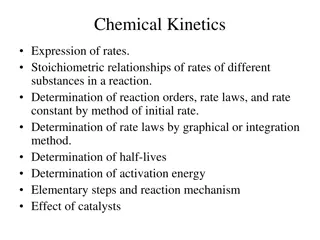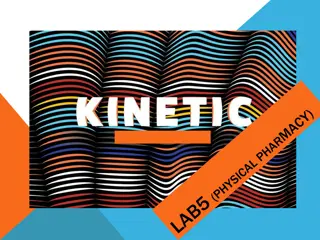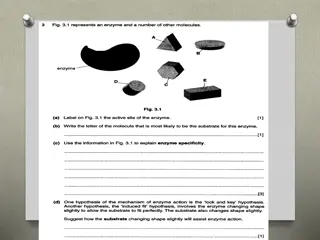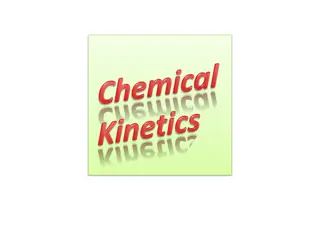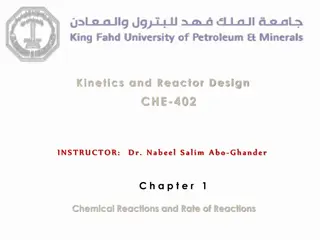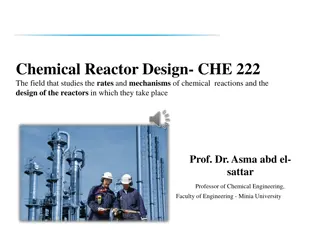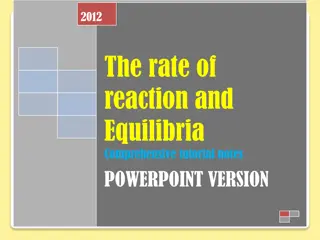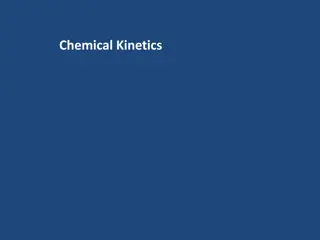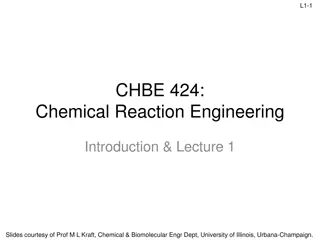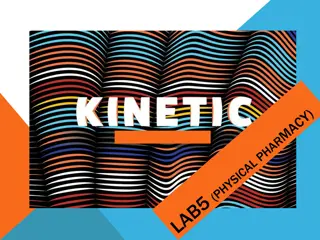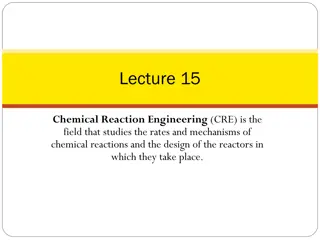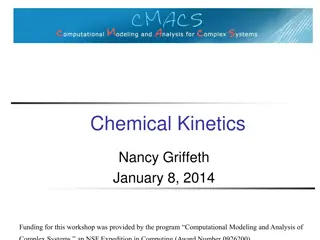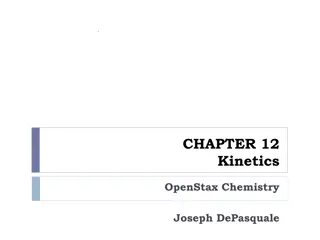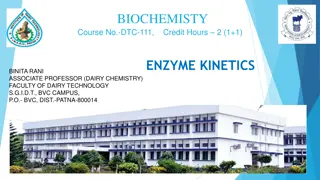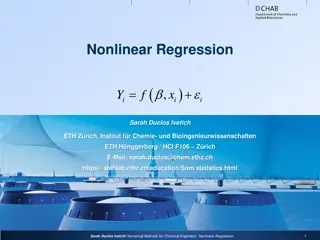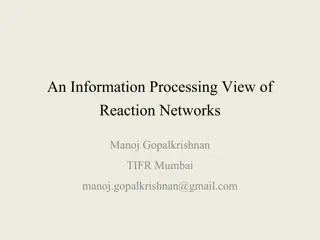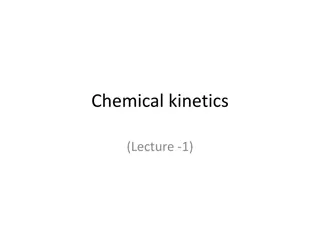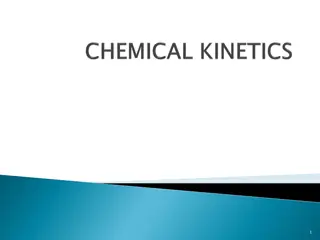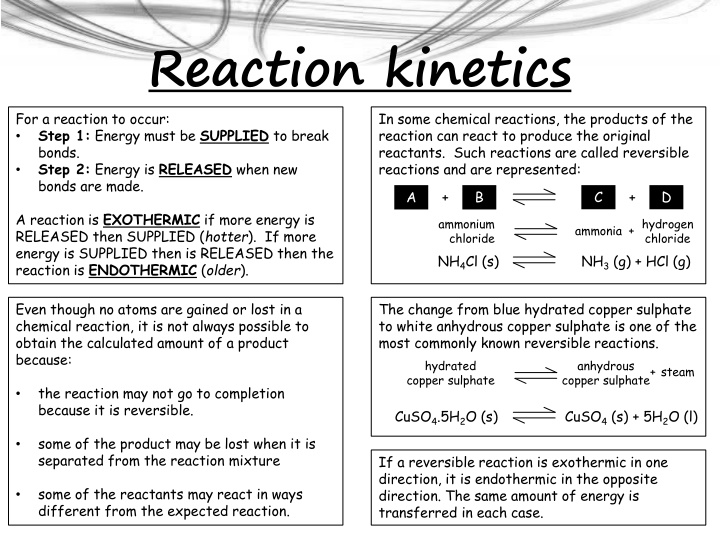
Reaction Kinetics and Rates
Learn about reaction kinetics and rates, including exothermic and endothermic reactions, reversible reactions, factors affecting reaction rates, and methods to measure reaction progress. Explore the role of energy in breaking and forming bonds and why not all reactions yield 100%. Discover how catalysts, surface area, temperature, pressure, and concentration influence reaction rates.
Download Presentation

Please find below an Image/Link to download the presentation.
The content on the website is provided AS IS for your information and personal use only. It may not be sold, licensed, or shared on other websites without obtaining consent from the author. If you encounter any issues during the download, it is possible that the publisher has removed the file from their server.
You are allowed to download the files provided on this website for personal or commercial use, subject to the condition that they are used lawfully. All files are the property of their respective owners.
The content on the website is provided AS IS for your information and personal use only. It may not be sold, licensed, or shared on other websites without obtaining consent from the author.
E N D
Presentation Transcript
Reaction kinetics For a reaction to occur: Step 1: Energy must be SUPPLIED to break bonds. Step 2: Energy is RELEASED when new bonds are made. In some chemical reactions, the products of the reaction can react to produce the original reactants. Such reactions are called reversible reactions and are represented: C D A + B + A reaction is EXOTHERMIC if more energy is RELEASED then SUPPLIED (hotter). If more energy is SUPPLIED then is RELEASED then the reaction is ENDOTHERMIC (older). ammonium chloride hydrogen chloride + ammonia NH4Cl (s) NH3 (g) + HCl (g) Even though no atoms are gained or lost in a chemical reaction, it is not always possible to obtain the calculated amount of a product because: The change from blue hydrated copper sulphate to white anhydrous copper sulphate is one of the most commonly known reversible reactions. hydrated copper sulphate anhydrous copper sulphate + steam the reaction may not go to completion because it is reversible. CuSO4.5H2O (s) CuSO4 (s) + 5H2O (l) some of the product may be lost when it is separated from the reaction mixture If a reversible reaction is exothermic in one direction, it is endothermic in the opposite direction. The same amount of energy is transferred in each case. some of the reactants may react in ways different from the expected reaction.
10 Questions For a reaction to occur why is energy supplied? Why is energy released during a reaction? If more energy is supplied than released is the reaction exothermic or endothermic? If a reaction is endothermic will the surroundings get warmer or colder? A reaction requires a lot of heat to take place, it is endothermic or exothermic? Is breaking bonds an endothermic or exothermic process? Give 2 reasons why a yield is not always 100%? What is the symbol for a reversible reaction? Give an example of a reversible reaction. 10. If a reversible reaction is exothermic in 1 direction what must it be in the other? 1. 2. 3. 4. 5. 6. 7. 8. 9. Reaction kinetics
Reaction rates Reactions occur when particles collide with sufficient energy. The minimum amount of energy required for particles to react on collision is called the activation energy. Amount of product formed Slower rate of reaction here due to reactants being used up Factors affecting reaction rate Concentration: Increasing concentration increases number of collisions and increases rate Temperature: Particles have more energy and move faster and collide more often. More particles have energy greater than the activation energy so more successful collisions Catalyst: Catalysts change the rate of chemical reactions but are not used up during the reaction. Different reactions need different catalysts. Catalysts are important in increasing the rates of chemical reactions used in industrial processes to reduce costs. Pressure: Increasing pressure increases the number of collisions as the particles are closer. Surface area: Increases the number of collisions as there is more surface exposed Fast rate of reaction here Slower reaction Time Reaction can be followed by: Loss in mass if gas produced. Measuring volume of a gas produced every min. Appearance/disappearance of colour. Change in pH etc. ???? ?? ???????? =?????? ?? ???????? ???? ???? ???? ?? ???????? =?????? ?? ??????? ?????? ????
10 Questions What equipment can be used to measure the mass of a product? In terms of reactants how do we know when a reaction is completed? State 2 ways in which a reaction can be followed. Define activation energy. How do catalysts effect the activation energy? How does this change the rate of a reaction? 1. 2. 3. 4. 5. 6. Describe how the following factors effect the rate of a reaction in terms of amount (frequency) of collisions and energy of collisions? 7. 8. 9. 10. Grinding up solid calcium carbonate into a powder. Increasing the temperature. Decreasing the concentration. Increasing the pressure of gaseous reactants. Reaction rates
Mark Scheme Reaction kinetics 1. To break bonds 2. Bonds are made 3. Endothermic 4. Colder 5. Endothermic 6. Endothermic 7. Yield is never 100% because: The reaction may not go to completion because it is reversible. Some of the product may be lost when it is separated from the reaction mixture Some of the reactants may react in ways different from the expected reaction. Reaction rates 1. Balance (or) Scales 2. There are no reactants remaining 3. Amount of product formed (and) Amount of reactant used. 4. Reactions occur when particles collide with sufficient energy. The minimum amount of energy required for particles to react on collision is called the activation energy. 5. Catalysts lower the activation energy. 6. Speeds it up 7. Rate increases as frequency and energy of collisions increases. 8. Rate decreases as only the frequency of collisions decreases. 9. Rate increases as only the frequency of collisions increases. 10. Rate increases as the surface area is increased, therefore increasing the frequency of collisions increases. 8. 9. NH4Cl (s) NH3 (g) + HCl (g) 10. Endothermic

